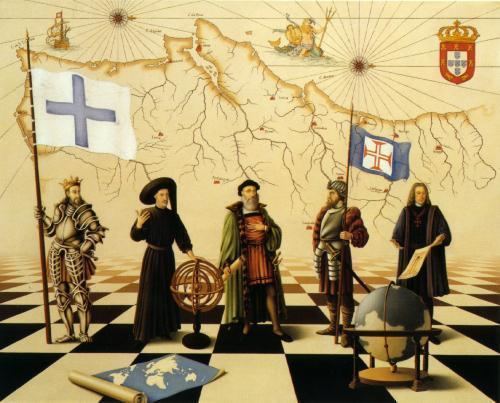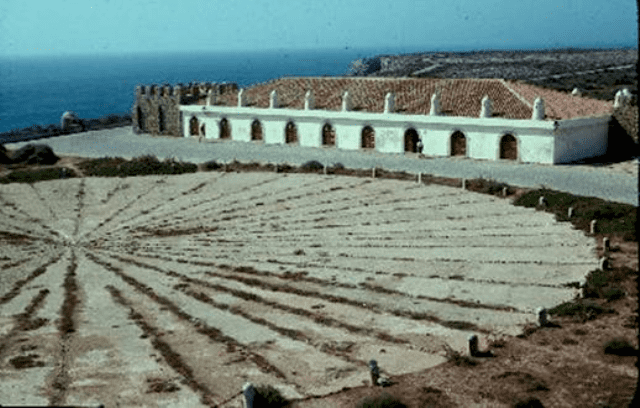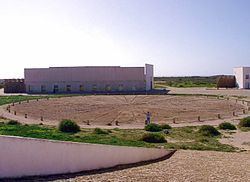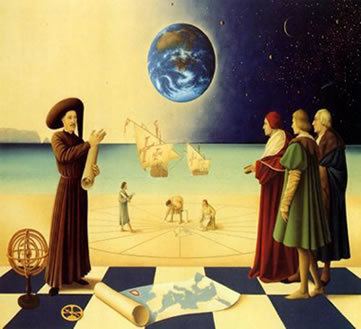 | ||
A escola de sagres
The School of Sagres, also called Court of Sagres (in Portuguese Escola de Sagres) according to some historians was a group of scientific Portuguese personalities and techniques related to ocean navigation of the fifteenth century, formed around the infant Enrique, nicknamed the Navigator in Sagres near Cape St. Vincent, the southwestern end of the Iberian Peninsula, in the Algarve.
Contents
- A escola de sagres
- Hist ria do brasil a escola de sagres 15
- Romantic view
- Critical view
- Majorcan school influence
- First results
- References

While it is proven that the nearby port of Lagos they weigh anchor numerous expeditions of exploration and colonization along the African coast and Atlantic islands, the existence of the School of Sagres has been questioned by some historians, All historians agree that at least since the death of Prince Henry (1460), the driver of the Portuguese discoveries center was Lisbon .

The first written mention of the concept of School of Sagres dating from the seventeenth century by the English Samuel Purchas, although in the sixteenth century Damião de Gois pointed out a similar idea. Portuguese and English historians settled and popularized the term later on.

Hist ria do brasil a escola de sagres 15
Romantic view

In the nineteenth century began to spread a version of the biography of Prince Henry whereby he would have installed his court in Sagres in 1418, shortly after the capture of Ceuta by the Portuguese. There would be formed around him the best of "science and navigation" and building a shipyard and a palace with the first observatory in Portugal. They even wrote that Sagres represented modern refounding "the systematic study of applied science" in Christendom". Others nuanced that, more than a nautical school in the modern concept of the word, Sagres was a meeting place for sailors and scientists to exchange information and techniques, designing maps, shipbuilding and organize expeditions.

The diverse religious status (Jews, Muslims, Christians) of the members of the alleged Sagres school, and even the ability to remotely connect them with the Templars given the fact that Prince Henry was the commander of the Order of Christ, have increased the romantic halo that sometimes appears.
Critical view

According to the critical view, the Portuguese learned navigation in a practical way, on the decks of the ships, and not being able to find archaeological and documentary support for the "Escola de Sagres", they consider it a myth of Portuguese history.
Majorcan school influence
The majorcan school influence on the Portuguese "navigation know how" is asserted by Julio Rey Pastor who says in his book La Cartografía Mallorquina (citing João de Barros and Pacheco Pereira).. "..That Jehuda Cresques (c. 1415) acted as founder and director of the Escola de Sagres, was known to historians for over a century, with doubts on which mestre Jacome from Majorca corresponded to the mestre Jacome contracted by Prince Henry, (although he was the only cartographer with that name). But it's unforgivable some scholars arrived to the point (based in a high cartographic ignorance), to attribute the invention of portolans to the school of the Infant, if not to him personally .. but how could that make sens, being the school founded by the emigrated Cresques (about 1400), when at his seventies he was tired of manufacturing planispheres, during half a century, for the insatiable Peter the Ceremonious and for his son, the also map-maniac DON JOAN.. On top of that one should not forget to include the testimony of Pacheco Pereira...:
..Muijos beneficios tem feytos o virtuoso Infante Dom Anrique a estes Reynos de Portugal, por que descubrió a ilha da Madeyra no anno de nosso senhor de mil CCCCXX, e ha mandau pouoar e mandou a Cicilia pellas canas de açuquar, ...; isso mesmo mandou á ilha de Malhorca por um mestre Jacome, mestre de cartas de marear, na qual ilha primeiramente se fezeram as ditas cartas, e com muitas dadiuas e mercés ho ouue nestes Reynos, ho qual as ensinou a fazer áquelles de que os que em nosso tempo viuem, aprendéram...
And he continues.. It's unforgivable as well, that those scholars, could dare to write on the subject without reading João de Barros, which clearly states: "..mándou vir da ilha de Mallorca um mestre Jacome, hornera mui douto na arte de navegar, que fasia e instrumentos náuticos e que Ihe custou muito pelo trazer a este reino para ensinar sua sciencia aos officiaes portuguezes d'aquella mester.."
First results
João Gonçalves Zarco arrived at Porto Santo (1419) and Madeira (1420), and on the other part Diogo de Silves found the island of Santa Maria at Azores (1427). In 1434 Gil Eanes doubled Cape Bojador, the westernmost point of Africa. This meant a period of twelve years to navigate across two hundred miles that separate the Cape Não from Cape Bojador. From this point, the Dark Sea was feared by Arab geographers for the difficulty of the return trip, sailing against the prevailing winds. This problem could be sorted out at the end, by means of high sea sailing, returning by a route far away from the coast. This breakthrough was achieved in the second quarter of the fifteenth century. The suitable vessel was the Caravel, used for fishing and characterized for its robustness and shallowness, with a tonnage from 50 to 160 tonnes, with 1, 2 or 3 masts with triangular Latin sails.
